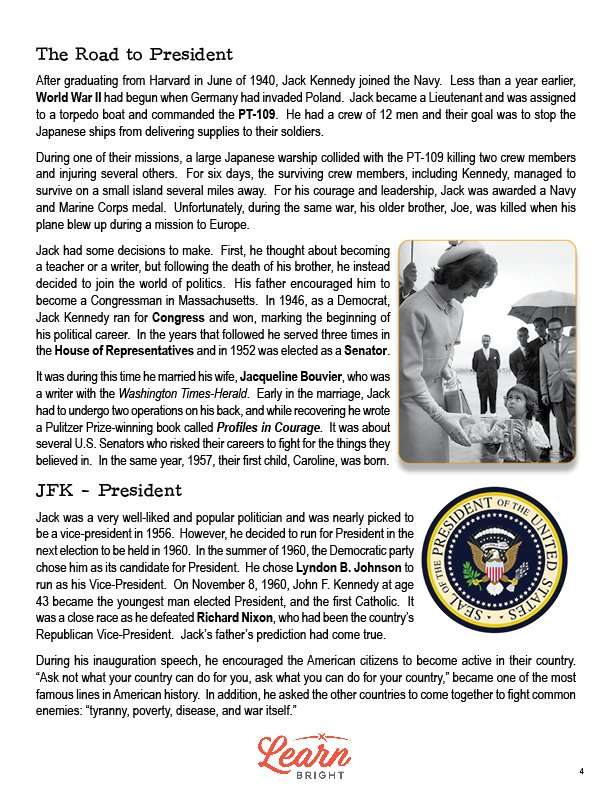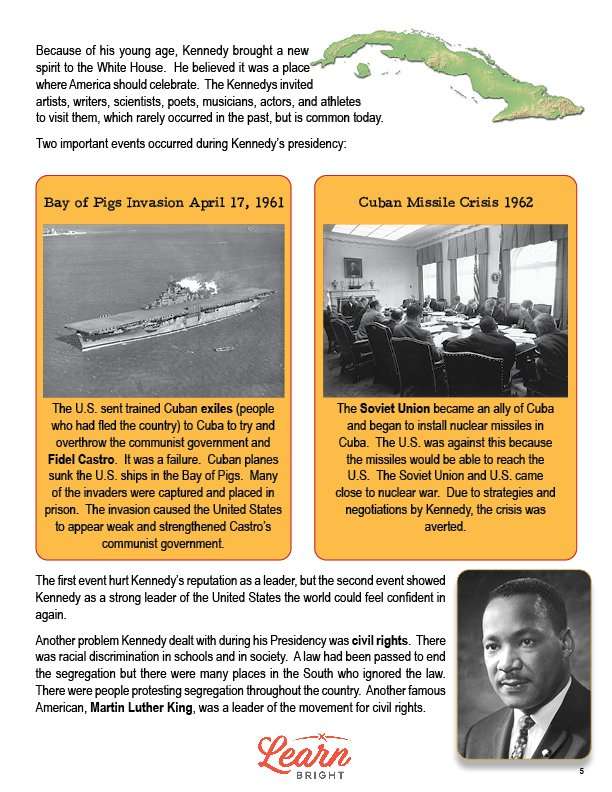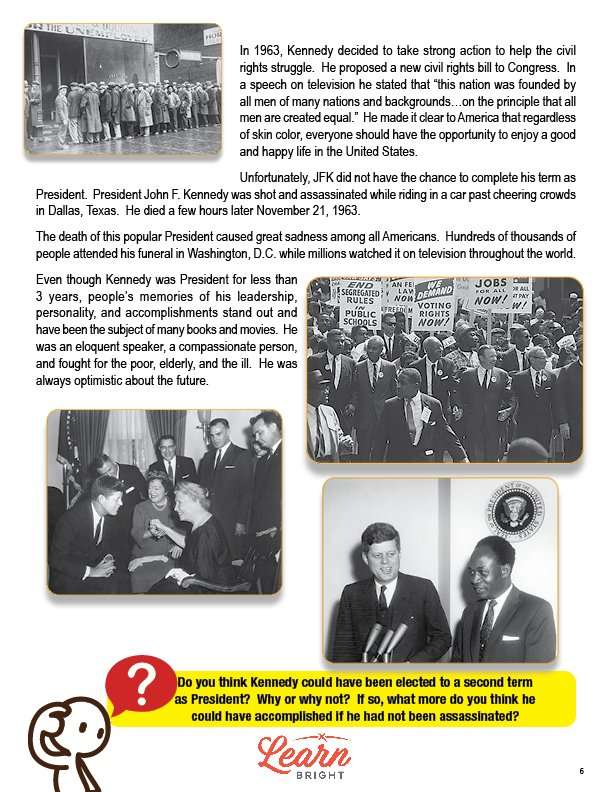Description
What our John F. Kennedy lesson plan includes
Lesson Objectives and Overview: John F. Kennedy introduces students to the 35th President of the United States, John F. Kennedy. The students will learn about Kennedy’s accomplishments and contributions as President of the U.S. The lesson includes some background of the Kennedy family, as well as some of the events Kennedy had to confront during his presidency including the Bay of Pigs and the Cuban Missile Crisis. Finally, the events surrounding Kennedy’s assassination are reviewed as part of the lesson. At the end of the lesson, students will be able to identify John F. Kennedy, list significant contributions, and explain his influence on the United States and the world. This lesson is for students in 3rd grade, 4th grade, 5th grade, and 6th grade.
Classroom Procedure
Every lesson plan provides you with a classroom procedure page that outlines a step-by-step guide to follow. You do not have to follow the guide exactly. The guide helps you organize the lesson and details when to hand out worksheets. It also lists information in the orange box that you might find useful. You will find the lesson objectives, state standards, and number of class sessions the lesson should take to complete in this area. In addition, it describes the supplies you will need as well as what and how you need to prepare beforehand. To prepare for this lesson ahead of time, you can group students in groups of three or four and copy the handouts.
Options for Lesson
Included with this lesson is an “Options for Lesson” section that lists a number of suggestions for activities to add to the lesson or substitutions for the ones already in the lesson. An optional adjustment to this lesson is to use the activity as a class discussion instead of a group discussion. For an additional activity, you can have students research the events of JFK’s life using the internet. You could also assign each student an event or two and have them research them and present what they learn to the class. For another additional activity, you can plan and celebrate JFK Day and have students give mock speeches, discuss strategies for the Bay of Pigs, and more. Finally, you can have students create signs advocating for civil rights for all.
Teacher Notes
The teacher notes page includes a paragraph with additional guidelines and things to think about as you begin to plan your lesson. This page also includes lines that you can use to add your own notes as you’re preparing for this lesson.
JOHN F. KENNEDY LESSON PLAN CONTENT PAGES
Early Life of JFK
The John F. Kennedy lesson plan includes four pages of content. John F. Kennedy was the 35th President of the United States. He was born on May 29, 1917 in Brookline, Massachusetts. His father was Joseph Patrick Kennedy and his mother was Rose Fitzgerald Kennedy. They called him Jack and he was the second of nine children (four boys and five girls). His grandfather was a former mayor of Boston.
When he was three, Kennedy became sick and his parents thought he might die. He had a disease called scarlet fever, which was very serious during that time. He spent a month in the hospital but then started to recover. Kennedy suffered from several different illnesses during his childhood.
Kennedy’s family was wealthy because his father was a successful businessman in Boston. They lived a comfortable life and had nannies and housekeepers. However, his father had high expectations for his children and spoke to them about how important it was to work hard. He wanted his children to win everything. Kennedy went to boarding school and played tennis, basketball, football, and golf. He liked reading but did not do great in most subjects in school.
Kennedy started college at Harvard when he was 19 years old. He played sports, joined student groups, and worked hard in his history and government classes. At this time, his father predicted that he would be the first Catholic President of the United States.
Kennedy and one of his older brothers were both at school at Harvard in 1937 when their family moved to England, where his father became the U.S. Ambassador to England. Kennedy visited them during the summer and became interested in international affairs. This may have been when he started thinking about a career in politics.
The Road to President
Kennedy graduated from Harvard in June 1940 and joined the Navy. World War II began less than a year later with the invasion of Poland by Germany. Kennedy became a Lieutenant, worked on a torpedo boat, and commanded the PT-109. He and a crew of 12 men worked to stop Japanese ships from delivering supplies to their soldiers.
While working in this role, a Japanese ship collided with the PT-109 and killed two crew members. The surviving six crew members, including Kennedy, survived on a small isolated island. The Navy and Marine Corps gave Kennedy a medal for his service during this time. Unfortunately, during the war, Kennedy’s older brother, Joe, died when his plane blew up during a mission.
Following the war, Kennedy needed to decide what to do with the rest of his life. He thought about becoming a teacher or writer, but decided to go into politics because of his brother’s death. His father encouraged him to run for Congress in Massachusetts, which he did in 1946. He won running as a Democrat. After that, he served three terms in the House of Representatives. Next, in 1952, he ran for Senate and won.
During this time, he married Jacqueline Bouvier, a writer for the Washington Times-Herald. Early in their marriage, Kennedy had two back surgeries and wrote his book Profiles in Courage, which won the Pulitzer Prize, while recovering. The book was about U.S. Senators who risked their careers to fight for what they believed in. Also in this year, 1957, Kennedy and his wife had their first child, Caroline.
JFK – President
JFK was a well-liked and popular politician. They almost picked him to be vice president in 1956. Instead, he decided to run for President in 1960. The Democratic party chose him as their nominee and Kennedy chose Lyndon B. Johnson as his Vice President. Kennedy won the election on November 8, 1960, becoming the youngest man ever elected President (at 43 years old) and the first Catholic. He defeated Richard Nixon, the previous Republican Vice President.
In his inauguration speech, he spoke about Americans getting involved in making their country better, including the famous line, “Ask not what your country can do for you, ask what you can do for your country.” He also asked other countries to fight the common enemies of tyranny, poverty, disease, and war.
Kennedy’s youth brought a new energy to the White House, because he thought it should be a place where America should celebrate. They invited writers, poets, scientists, musicians, actors, athletes, and more to visit them there. This was rare at the time but is common today.
Two very important events happened during Kennedy’s presidency: The Bay of Pigs Invasion in 1961 and the Cuban Missile Crisis in 1962.
The Bay of Pigs Invasion happened on April 17, 1961. At that time, the U.S. sent Cuban exiles (people who had fled the country) to Cuba in an attempt to overthrow their communist government and their leader, Fidel Castro. This plan failed miserably when Cuban planes sunk the U.S. ships in the Bay of Pigs. Cuba captured and imprisoned many of the people that the U.S. had sent. This incident made the U.S. look weak and strengthened Castro’s government.
The Cuban Missile Crisis happened in 1962. The Soviet Union and Cuba became allies and started to place nuclear weapons in Cuba. The U.S. did not want this to happen because those missiles could reach the United States. The Soviet Union and the U.S. came close to nuclear war, but Kennedy’s negotiations helped avert the crisis.
The Bay of Pigs was not good for Kennedy’s reputation, but the result of the Cuban Missile Crisis showed that he was a strong leader who the people of the United States could have confidence in.
Another big issue at this time was civil rights. Racial discrimination was rampant in schools and in society as a whole. The government passed a law to end segregation but many places through the U.S., and in the South in particular, ignored it. People then began to protest segregation throughout the country, and Martin Luther King became a leader in the Civil Rights Movement.
Kennedy decided to take action on this issue in 1963, when he proposed a new civil rights bill to Congress. He gave a speech on national television where he said that “this nation was founded by all men of many nations and backgrounds…on the principle that all men are created equal.” He said that everyone, regardless of their skin color or race, should have equal rights and the opportunity to have a good life.
JFK was not able to complete his first term. On November 21, 1963, a man shot and assassinated Kennedy while he was riding in a car in Dallas, Texas. He died a few hours later. The death of such a popular President caused lots of sadness across the United States. Hundreds of thousands of people attended his funeral in Washington, D.C. Millions more throughout the world watched it on television.
Kennedy was President for less than three years. People remember his leadership, personality, and accomplishments. He was a great speaker, a compassionate person, and he fought for the poor, the elderly, and the ill.
JOHN F. KENNEDY LESSON PLAN WORKSHEETS
The John F. Kennedy lesson plan includes three worksheets: an activity worksheet, a practice worksheet, and a homework assignment. You can refer to the guide on the classroom procedure page to determine when to hand out each worksheet.
GROUP DISCUSSION ACTIVITY WORKSHEET
Students will work in groups to complete the activity worksheet. Each group will discuss each of the questions listed with their group members. After they discuss, each group member will write their personal response to each question down. They will share their responses with the class.
MATCHING PRACTICE WORKSHEET
The practice worksheet asks students to first match the person to their description. Next, they will match the event, date, or thing to its description.
JOHN F. KENNEDY HOMEWORK ASSIGNMENT
For the homework assignment, students will answer four questions about the lesson material to demonstrate their understanding of the lesson.
Worksheet Answer Keys
This lesson plan includes answer keys for the practice worksheet and the homework assignment. If you choose to administer the lesson pages to your students via PDF, you will need to save a new file that omits these pages. Otherwise, you can simply print out the applicable pages and keep these as reference for yourself when grading assignments.










